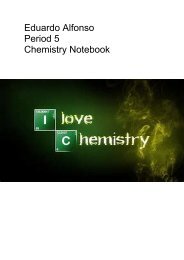You also want an ePaper? Increase the reach of your titles
YUMPU automatically turns print PDFs into web optimized ePapers that Google loves.
Hydrates<br />
the water contained in a crystal is called the (11 water of hydration or water of crystallization. A<br />
compound that contains water of hydration is called a (12 hydrate. The forces holding the water<br />
molecules in hydrates is not very strong. A substance that is (13 anhydrous does not contain any<br />
water. If a hydrate has a vapor pressure higher than the pressure of water vapor in the air, the<br />
hydrate will lose its water of hydration or (14 effloresce. Hydrated ionic compounds that have a low<br />
vapor pressure remove water vapor from moist air to form higher hydrates. These hydrates and other<br />
compounds that remove moisture from the air are called (15 hygroscopic. Water can be removed<br />
from such substances by heating. Some compounds are so hygroscopic that they become wet when<br />
exposed to normally moist air. These compounds are (16 deliquescent, which means that they<br />
remove sufficient water to dissolve completely to form solutions<br />
15.3 Heterogeneous Aqueous Systems<br />
Suspensions<br />
heterogeneous mixtures are not solutions. A (17 suspension is a mixture from which particles settle<br />
out upon standing. Particles in a suspension are much larger and do not stay suspended indefinitely.<br />
All substances within the mixture can be clearly identified.<br />
Colloids<br />
Heterogeneous mixtures containing particles that range in size from 1 nm to 1000nm, such as gelatin<br />
are called colloids 18 . Glues were the first substances to be identified as colloids. Examples of other<br />
colloids include paint, aerosol sprays, and smoke. The main different between colloids and solutions<br />
and suspensions is the size of its particles. Colloidal particles can cause the tyndall effect 19 where<br />
they scatter visible light all over the place. The chaotic motion in which colloidal particles move is<br />
called Brownian Motion 20 . Colloidal dispersion of a liquid in another liquid is called Emulsion 21 .<br />
131



